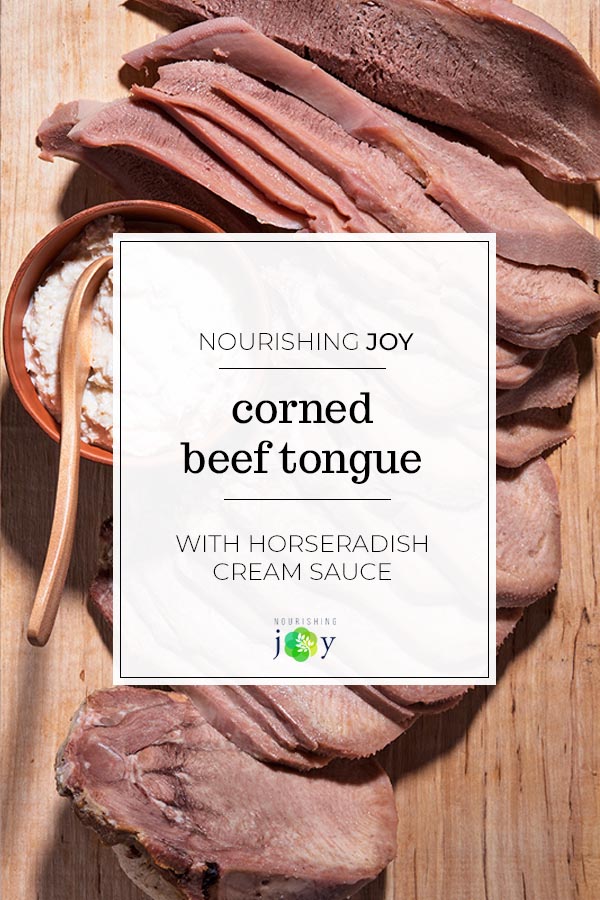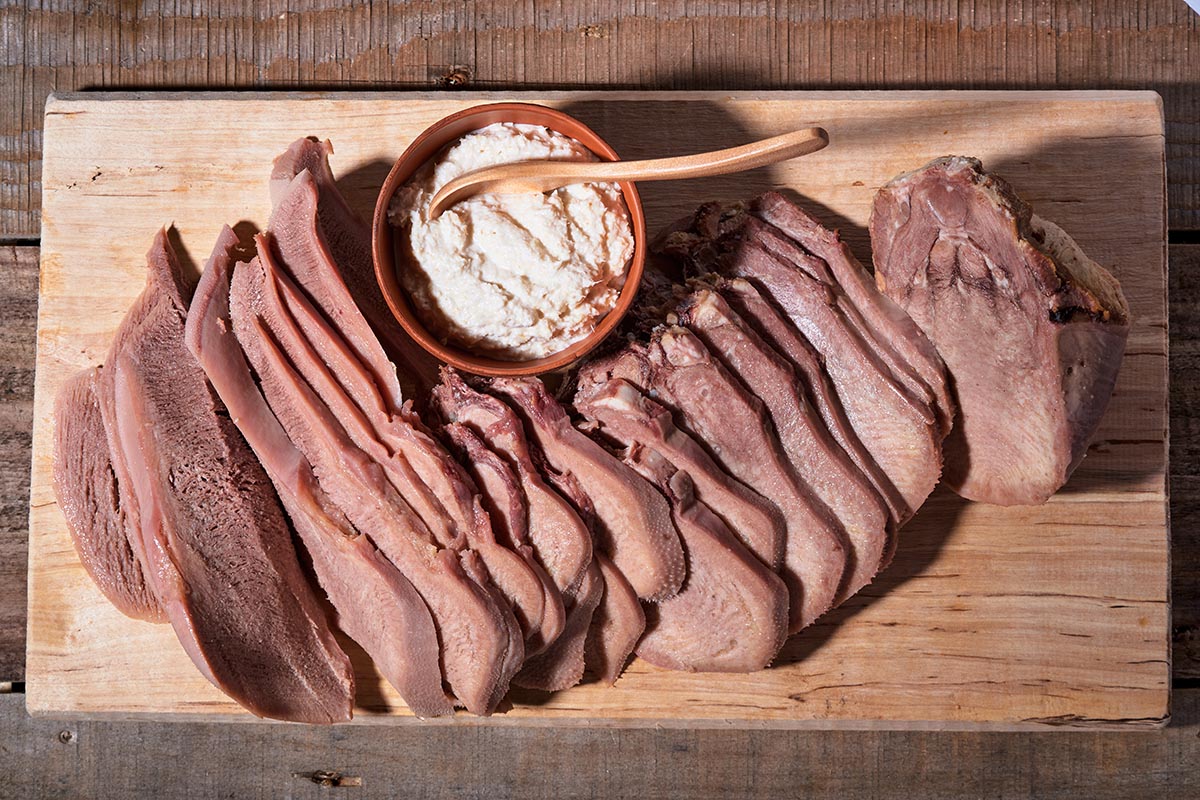Corned Beef Tongue and Horseradish Cream Sauce
This post may contain affiliate links, including those from Amazon.com, which means we earn a small commission off your purchases. And here's the thing: We only mention services and products that we think are truly worth your attention, whether they're free, paid, or otherwise. This site relies on YOUR trust, so if we don't stand behind a product 110%, it's not mentioned. Period.



March is the time when it's “traditional” in this corner of the world to brine some corned beef and drink a pint of Guinness.
Problem is – when I opened my freezer this weekend to grab a brisket to thaw, there was no brisket to be found. What to do?
After tsk-tsking lightly under my breath (as I really love corned beef and look forward to the annual ritual), I realized we had a plethora of beef tongue left over from our last beef purchase, so my mental wheels started turning. I've been looking for creative ways to use tongue – perhaps a several day stint in a brine might be just the ticket for a firm muscle like tongue.
And sure enough, I wasn't the first one to have thought of this. America's Test Kitchen even has beautiful step by step photos of their method of preparing it.
So, this year, it's corned beef tongue in our house with our absolute favorite horseradish cream sauce. (It will make you swoon. I promise. Even if you don't like horseradish.)
And then, of course, the leftovers will be used in Reuben sandwiches and picnic buns. I can't wait!
And by the way, I liked this preparation of tongue so much that in future years, I may well turn to using tongue for this purpose anyway, as tongue is far cheaper than brisket and it's great later when it's shredded.
Enjoy!
Corned Beef Tongue
1 beef tongue
1 cup unrefined coarse sea salt
1/4 cup unrefined cane sugar (optional, no substitutes)
Pickling spice (recipe follows)
5 cloves of garlic, minced
2 cups whey or sauerkraut brine*
2 cups celery juice
*Get sufficient whey by straining 2-3 quarts of yogurt in cheesecloth for an hour or so – plus you end up with thick Greek-style yogurt. Delicious!
Pickling Spices:
3 bay leaves
1 stick cinnamon, broken into pieces
2 tablespoon mustard seeds
2 tablespoon whole coriander seed
2 tablespoons whole black peppercorns
1 tablespoon whole cardamom pods (optional)
1 tablespoon juniper berries
4 cloves
If your meat is frozen, thaw it completely. This is necessary to allow the spices to really adhere to the meat, as well as to allow the brine to easily penetrate the meat.
Rinse the tongue and pat it dry.
Mix the salt, sugar, pickling spices, and garlic together in a small bowl, breaking up the bigger items with the back of a spoon (or use a mortar and pestle to make it easy). Rub as much of the mixture into the meat as possible, massaging it in if needed.
Place the tongue in a restaurant-style prep bin or glass container with a tight-fitting lid. Pour the whey and the celery juice over the brisket, along with any of the salt mixture that fell aside. If the brine does not cover the tongue entirely, add enough filtered water to cover it. Weigh it down if necessary with a plate or a jar filled with water.
Place the lid on the container and set in the refrigerator. Let it cure for 5-10 days, turning once each day and ensuring that the meat is covered in brine at all times. Add filtered water if necessary.
Once the meat is cured, toss the brine and rinse the meat to reduce the saltiness.
Preheat the oven to 300° F. Partially submerge the tongue in fresh water in an oven-safe stockpot or a Dutch oven and bring to a boil. (You may add a few tablespoons of pickling spice if you'd like.) Place the pot in the oven and braise for about 3 hours, or until the meat is tender. Alternatively, place the rinsed tongue in a crockpot with 2-3 inches of water and cook on high for 5-6 hours.
When the meat is cooked, you'll need to remove the skin, as it's very tough. Slice through the skin lengthwise on the bottom of the tongue, then peel it off. (The photos at America's Test Kitchen show this step very clearly.)
Slice the tongue into 1/2-inch slices (if possible) or shred the meat. Pile on the serving plates and pour or dollop the horseradish cream beside.
Mashed potatoes and boiled beets accompany this meal superbly.
Horseradish Cream
This recipe is from my book, Restocking the Pantry. (Get free sample pages.)
1/4 cup heavy cream
1 cup sour cream OR crème fraiche
6 tablespoons finely grated fresh horseradish OR traditionally fermented horseradish, such as Bubbies
1 tablespoon Dijon-style mustard
1 teaspoon white wine vinegar
1 tablespoon fresh chives, finely snipped
1/2 teaspoon unrefined sea salt
black pepper to taste
Place the heavy cream in a large bowl and whisk until it begins to thicken and form soft peaks. Add the sour cream, grated horseradish, mustard, and vinegar and whisk vigorously again until the mixture is smooth. Add the chives, salt, and pepper and stir to incorporate well.
Refrigerate for at least 4 hours. Sauce can be stored in the refrigerator in an airtight container for 2 to 3 weeks.





I would love to use tongue. I just cannot get over how it looks. I’m guessing in your picture that those dimples are still the taste buds? I am such a texture, visual person when I eat and am afraid I wouldn’t be able to get through the initial thought of eating a tongue.
I’ve made this many, many times. More people should cook and eat tongue!
Shannon, Tongue is delicious, and if you eat the rest of the cow you should eat tongue! You don’t think about how gross muscle is, now do you?
Wow, I wonder if I would ever have thought of corning a tongue? That horseradish sauce sounds brilliant.
I’m using pork tongue from our pastured pork.
I’m excited about the outcome.
Where I come from (eastern europe) cow tongue is considered a delicacy and is actually pretty expensive. I was delighted to discover how cheap it is here, in US. The way we cook it there is very simple – just boiling. And then you chill it and eat it cold with horseradish and other savory sauces. It is always so tender, despite it being a “muscle”. When my American husband first tried it (without knowing what it was), he was praising this tender piece of meet. When he realized he just ate a cow tongue, he was in shock. Bless his heart! 🙂 Stereotypes are hard to get over!